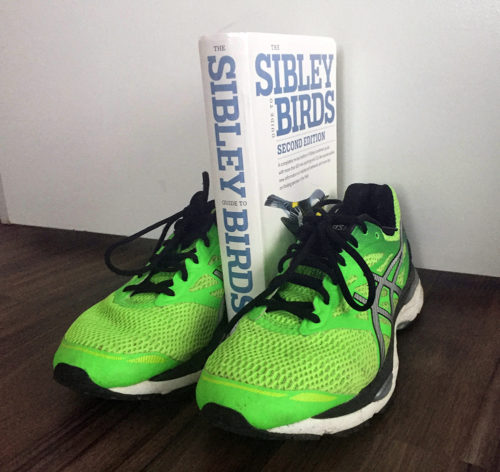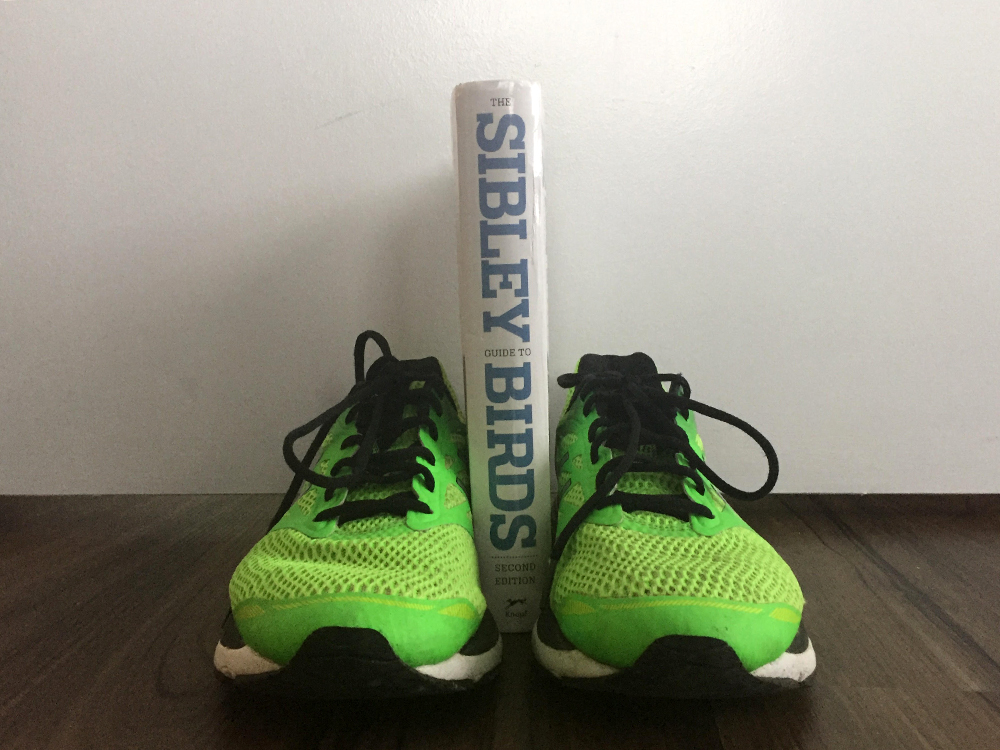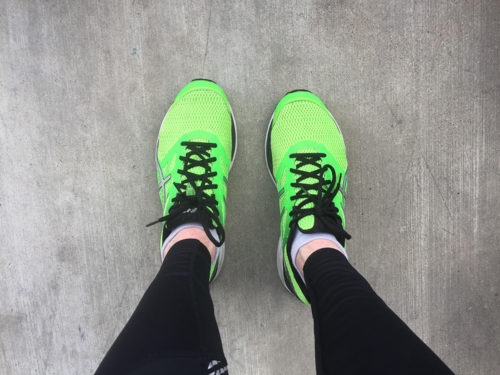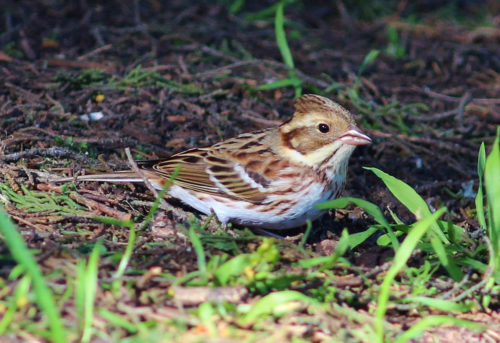It all started with a simple question: How many species have I seen while running? I’m relatively list adverse compared to other birders; state, county and yard lists are common examples, but, more obscurely, I’ve heard of a “C List,” or the number of species a birder has seen copulate. For me, I only keep lists for US/Canada — known among birders as an “ABA” list — and a world list, the latter of which is haphazardly scribbled throughout field guides and pads of aging paper. That’s all to say that I’m not inclined to keep lists, nor am I very good at it.

But with a toddler and two time-consuming hobbies, the idea of combining birding and running into one pursuit intrigued me.
Plus, it appeared novel—I hadn’t heard of anyone else attempting something like this before.
After the 12 month “Big Year” (a term I use very loosely) I maintained my normal “3 runs a week” schedule, tallying 138 individual runs. While birds influenced the destination of every single run, except for the last run of the year on December 31, I didn’t drive anywhere to specifically target birds. I ran from whenever I slept. Most frequently this was Washington D.C (81% of all runs left from our apartment near Chinatown).
In addition, I ran wherever we traveled and thankfully this included some interesting areas:
- Seattle-area, WA (13 runs)
- Arlington, VA (7 runs)
- San Francisco-area, CA (4 runs)
- Phoenix, AZ (1 run)
- Bethany Beach, DE (1 run)
I never used optics, more out of practicality instead of principles—they are heavy. Consequently, many duck silhouettes bobbing on the water and warbler butts went unidentified. I included “heard only” birds and considering my nascent familiarity with Eastern birds, this meant I missed a few more birds, especially during spring migration.
If I could sum up the effort in two words, it’d be “so close.” I ran 984 miles and saw or heard 197 species. This is much better than the 100 species I suspected, but I was so close to doubling my arbitrary goal.
Which species did I record the most? This list reflects my largely urban running environment:
- European Starling (90% of runs)
- Rock Pigeon (84% of runs)
- American Robin (84% of runs)
- House Sparrow (84% of runs)
- Mallard (72% of runs)
- Blue Jay (65% of runs)
- Canada Goose (61% of runs)
- Fish Crow (60% of runs)
- Ring-billed Gull (59% of runs)
- Song Sparrow (58% of runs)
- Common Grackle (57% of runs)
Of the 197 species I saw or heard this year while running, 28% I recorded only once and more than half (58%) I recorded on 5 or fewer runs.
Which species did I totally miss this year? There are more than a few species that I somehow couldn’t find in 2018 while running, but the rare Black-headed Gull that was frequenting the Georgetown waterfront for a couple months probably stings the most. Including “out and backs,” I probably made nearly 20 attempts to see this stupid bird. People were feeding it bread, for crying out loud. It was most frequently reported in the afternoon and I prefer to run in the morning. Looking back, I should have changed my strategy.
Other surprising misses include Peregrine Falcon and Ruby-throated Hummingbird in D.C., Marsh Wren and Eurasian Collared-Dove out west. Cackling Goose and Sharp-shinned Hawk also stand out. I ran 14 miles on one run for a failed attempt at Long-tailed Duck near Georgetown and, back near Seattle, 16 miles to *not* find a Brandt’s Cormorant. A couple runs to a supposed Mississippi Kite nest site was also fruitless (the nest apparently failed).
But let’s not dwell on the negative. Here are some highlights:
January — I ended the month with 48 species and a partially hurt foot. The most exciting bird was the reddish wings and gray collar of a SWAMP SPARROW at Theodore Roosevelt Island, what will become a frequent destination this year.
February — The January foot issue crept into February and, not wanting to impact an expensive ski vacation, I took two weeks off from running—not the strongest start to the year. I ran 37 miles in the latter half of February and tallied six new species, including GREAT BLACK-BACKED GULL and ORANGE-CROWNED WARBLER.
March — I crawled back to my “3 run a week” schedule and with that increased mileage came new species, including a rare LARK SPARROW in the National Arboretum and a flock of RUSTY BLACKBIRDS—my second sighting ever (with or without running shoes). I also ran the Rock & Roll Half Marathon and added a COMMON RAVEN.
April — Spring Migration is starting and the action is picking up! I missed a rare Great Cormorant reported the previous day at Fletcher’s Cove but added six new species, including HAIRY WOODPECKER and BLACK VULTURE. I tallied SPOTTED SANDPIPER and GREEN HERON at Roosevelt Island but missed the Bonaparte’s Gulls reported just offshore. I ran 80 miles and added 25 more species.
May — Spring Migration treated me well, as expected. If the scads of warblers, grosbeaks, orioles and flycatchers in D.C. weren’t enough, I also took advantage of a bachelor party in arid Scottsdale, AZ. Perhaps I was not in peak aerobic fitness on the final morning of our trip, but I tallied 14 desert species, including HARRIS’S HAWK. All told, I tallied 37 new species in May.
June — Spring migration was a tough act to follow, but a half marathon to Kenilworth Park added WHITE-EYED and WARBLING VIREOS and INDIGO BUNTING. I also learned about a small PURPLE MARTIN colony breeding behind the Georgetown Hospital.
July — I took two weeks off of running to go on a European road trip but returned to D.C. to hear a singing FIELD SPARROW and – after three attempts – found a COOPER’S HAWK across the street from Union Station.
August — This could’ve been a dry month, but four runs near San Francisco afforded me a staggering 23 new species for the year, include West Coast specialties like WRENTIT, RIDGWAY’S RAIL, NUTTALL’S WOODPECKER, PYGMY NUTHATCH and – a personal highlight – foraging WHITE-TAILED KITES.
September — This was the month where I attempted to find Ruby-throated Hummingbird and Black-headed Gull and struck out on both, many times. I did tally 4 new species on one run in coastal Delaware, including BROWN-HEADED and RED-BREASTED NUTHATCHES thus completing the coveted quadfecta of North American nuthatches.
October — I added a YELLOW-BELLIED SAPSUCKER in D.C. and on one run back near Seattle – my first since January – I tallied SNOW GOOSE, BARROW’S GOLDENEYE, DUNLIN and BROWN CREEPER.
November — On my second run near Seattle, I tweaked my ankle looking in a flock of American Wigeons for a Eurasian. Then I caught a head cold. After a 9-day hiatus, I returned to running in D.C. to find HERMIT THRUSH, AMERICAN KESTREL and LESSER BLACK-BACKED GULL.
December — I was sitting at 179 species and 862 miles with 31 days left in this year-long challenge. Two hundred species and a thousand miles were so close, but it would require a very strong, if not stupidly ambitious finish. We were already planning to spend over two weeks in the Seattle-area, where I had the potential to see quite a few new species. I just needed some luck and injury-free knees. Thankfully, I stayed healthy and hit 122 miles – the highest mileage this year – including 35 miles in the last four days. And the birds didn’t disappoint either: VARIED THRUSH, EURASIAN WIGEON, RHINOCEROS AUKLET and EARED GREBE were the highlights of the 18 species I added in December. I tried to go out with a bang as well, running 14 miles on the last day of the year and scoring two dandies: HARLEQUIN DUCK and BLACK TURNSTONE.
I’m taking the first week of January off running before I resume my normal running schedule. I’m also creating a new version of my “ABA Running List” spreadsheet … just in case.
2018 “RUNNING LIST” – By the Numbers
Number of runs: 138
Total Mileage: 984 miles
Total Species: 197
Average Mileage: 7.1 miles per run
Snow Goose
Canada Goose
Wood Duck
Northern Shoveler
Gadwall
Eurasian Wigeon
American Wigeon
Mallard
Ring-necked Duck
Lesser Scaup
Harlequin Duck
Surf Scoter
White-winged Scoter
Bufflehead
Common Goldeneye
Barrow’s Goldeneye
Hooded Merganser
Common Merganser
Red-breasted Merganser
Ruddy Duck
Gambel’s Quail
Pied-billed Grebe
Horned Grebe
Red-necked Grebe
Eared Grebe
Rock Pigeon
Band-tailed Pigeon
White-winged Dove
Mourning Dove
Chimney Swift
Anna’s Hummingbird
Ridgway’s Rail
American Coot
Black-necked Stilt
American Avocet
Killdeer
Long-billed Curlew
Black Turnstone
Sanderling
Dunlin
Long-billed Dowitcher
Spotted Sandpiper
Greater Yellowlegs
Pigeon Guillemot
Rhinoceros Auklet
Laughing Gull
Mew Gull
Ring-billed Gull
Western Gull
California Gull
Herring Gull
Lesser Black-backed Gull
Glaucous-winged Gull
Great Black-backed Gull
Caspian Tern
Common Loon
Double-crested Cormorant
Pelagic Cormorant
Great Blue Heron
Great Egret
Green Heron
Black-crowned Night-Heron
Black Vulture
Turkey Vulture
Osprey
White-tailed Kite
Bald Eagle
Cooper’s Hawk
Harris’s Hawk
Red-shouldered Hawk
Red-tailed Hawk
Belted Kingfisher
Acorn Woodpecker
Gila Woodpecker
Red-bellied Woodpecker
Yellow-bellied Sapsucker
Red-breasted Sapsucker
Nuttall’s Woodpecker
Downy Woodpecker
Hairy Woodpecker
Northern Flicker
Pileated Woodpecker
American Kestrel
Merlin
Eastern Wood-Pewee
Acadian Flycatcher
Willow Flycatcher
Black Phoebe
Eastern Phoebe
Ash-throated Flycatcher
Great Crested Flycatcher
Western Kingbird
Eastern Kingbird
White-eyed Vireo
Hutton’s Vireo
Blue-headed Vireo
Warbling Vireo
Red-eyed Vireo
Steller’s Jay
Blue Jay
California Scrub-Jay
American Crow
Fish Crow
Common Raven
Purple Martin
Tree Swallow
Violet-green Swallow
Northern Rough-winged Swallow
Cliff Swallow
Barn Swallow
Carolina Chickadee
Black-capped Chickadee
Chestnut-backed Chickadee
Oak Titmouse
Tufted Titmouse
Verdin
Bushtit
Red-breasted Nuthatch
White-breasted Nuthatch
Pygmy Nuthatch
Brown-headed Nuthatch
Brown Creeper
House Wren
Pacific Wren
Winter Wren
Carolina Wren
Bewick’s Wren
Cactus Wren
Blue-gray Gnatcatcher
Golden-crowned Kinglet
Ruby-crowned Kinglet
Wrentit
Eastern Bluebird
Western Bluebird
Swainson’s Thrush
Hermit Thrush
Wood Thrush
American Robin
Varied Thrush
Gray Catbird
Curve-billed Thrasher
Brown Thrasher
Northern Mockingbird
European Starling
Cedar Waxwing
Phainopepla
House Sparrow
House Finch
Pine Siskin
Lesser Goldfinch
American Goldfinch
Spotted Towhee
Eastern Towhee
Canyon Towhee
California Towhee
Chipping Sparrow
Field Sparrow
Lark Sparrow
Black-throated Sparrow
Fox Sparrow
Song Sparrow
Swamp Sparrow
White-throated Sparrow
White-crowned Sparrow
Golden-crowned Sparrow
Dark-eyed Junco
Orchard Oriole
Hooded Oriole
Baltimore Oriole
Red-winged Blackbird
Brown-headed Cowbird
Rusty Blackbird
Common Grackle
Great-tailed Grackle
Ovenbird
Northern Waterthrush
Black-and-white Warbler
Orange-crowned Warbler
Lucy’s Warbler
Common Yellowthroat
American Redstart
Cape May Warbler
Northern Parula
Magnolia Warbler
Bay-breasted Warbler
Blackburnian Warbler
Yellow Warbler
Blackpoll Warbler
Black-throated Blue Warbler
Palm Warbler
Pine Warbler
Yellow-rumped Warbler
Prairie Warbler
Northern Cardinal
Rose-breasted Grosbeak
Blue Grosbeak
Indigo Bunting



